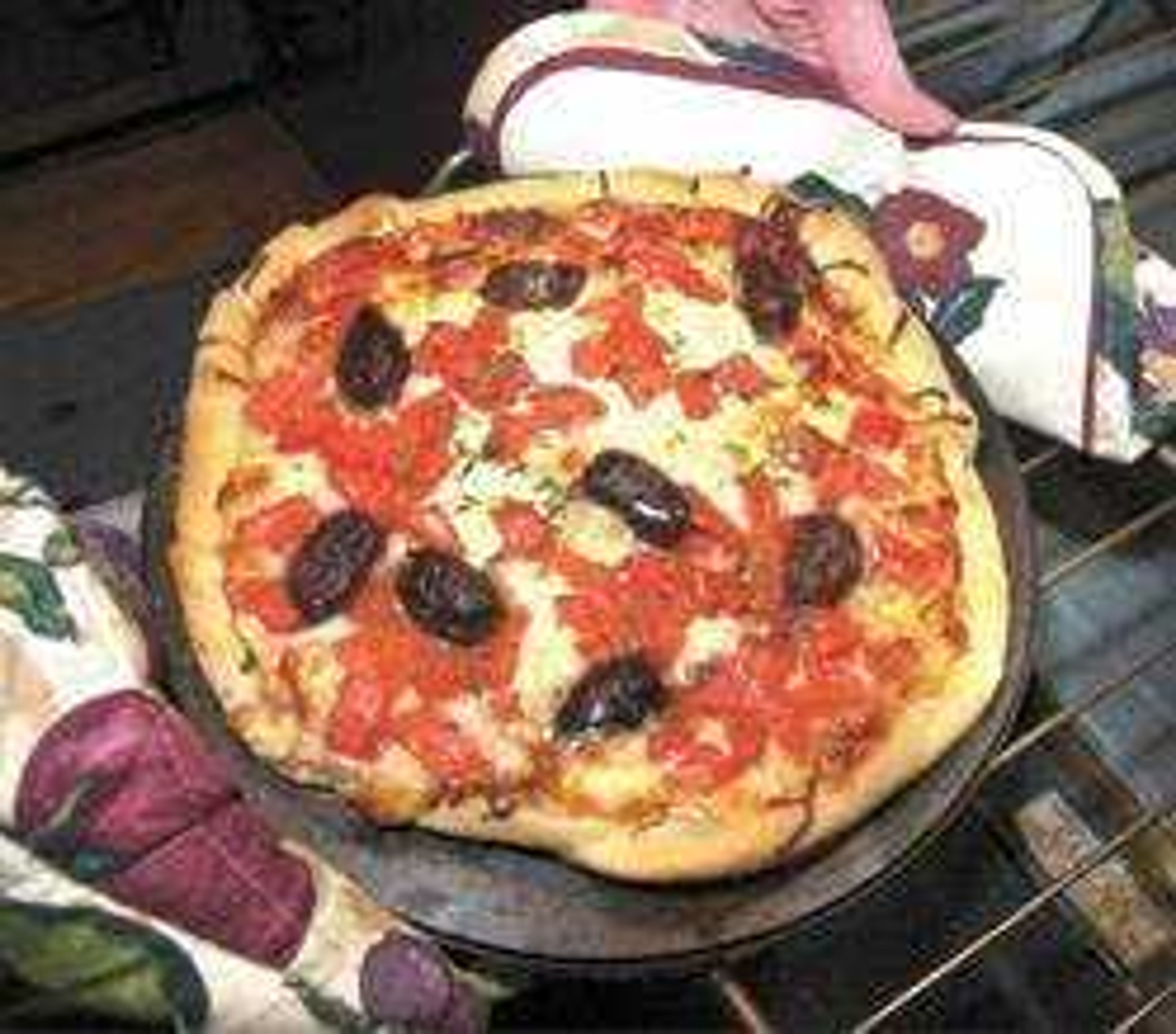Popularity of pizza
As Burton Anderson, writing in "Treasures of the Italian Table" has observed, "If Naples had managed to patent the pizza it would now be among Italy's wealthiest cities instead of one of its poorest." He is doubtless correct. You can now find pizza anywhere in the world. ...
As Burton Anderson, writing in "Treasures of the Italian Table" has observed, "If Naples had managed to patent the pizza it would now be among Italy's wealthiest cities instead of one of its poorest." He is doubtless correct.
You can now find pizza anywhere in the world. In India they top it with minced mutton, in Japan they favor eel and squid, in Russia red herring, in Brazil green peas, in Costa Rica coconut, in Australia shrimp, and in this country, of course, a wide variety of toppings bound together with tomato sauce. In fact, in the United States until just recently if a pizza did not contain tomato sauce, by law you could not label it pizza. (Such a regulation would dumbfound the crowds at Forno Campo de Fiori, a little hole-in-the-wall in the heart of Rome where I recently discovered what is reputed to be the best pizza bianca, i.e., white pizza, in the city.)
Yes, pizza is big around the world, especially in America, where it's a $30 billion-a-year industry. We eat an average of 46 slices per person per year which works out to about 100 acres of pizza eaten every day. Over the last five years the demand for pizza has grown faster than for any other food item. As P. J. O'Rourke wryly notes, if everything in life were determined by majority rule, we'd have pizza for every meal.
Given such demand, there's a lot of dough to be made in pizza. For example, in 1951 Rose and James Totino borrowed $1,500 from a Minneapolis bank (after she baked a pizza for the loan officer) and launched a frozen pizza business that later would be acquired by Pillsbury for $22 million. Rose became Pillsbury's first female vice president.
Similarly, in 1958 Frank Carney, after reading about the popularity of pizza among college students, borrowed $600 from his mother and went into business in Wichita, Kan. Today his Pizza Hut chain is the largest purveyor of pizza in the world, with annual sales in the billions.
Likewise, in 1961 Thomas Monaghan borrowed $500 to purchase a pizzeria in Detroit that would soon revolutionize the pizza delivery business. His Domino's Pizza is now the world leader in delivery with billions of dollars in annual sales at more than 5,000 stores in 46 international markets.
Then in 1982 pizza went gourmet when Wolfgang Puck, the third most famous Austrian after Mozart and Arnold Schwarzenegger, opened a restaurant on a shoestring (hence, the name Spago, which means "string") in Los Angeles. One day when an order of first-rate smoked salmon arrived and the restaurant was out of bread, he created a smoked salmon pizza and transformed the dish from hot to haute.
It is too bad for Naples that none of these entrepreneurs had to pay royalties, for they all capitalized on an idea that was born in that city. Though pizza's ancestry can be traced back to ancient times (Virgil refers to something like it in his "Aeneid"), the world's first true pizzeria, Antica Pizzeria Port'Alba, opened in Naples in 1830 with ovens lined with lava from Mount Vesuvius and is still in business today. But even before that, street vendors with small tin stoves on their heads peddled pizza throughout the city and poor Neapolitan housewives made "casa de nanza," thin dough topped, as often as not, with leftovers. By the late 18th century Queen Maria Carolina, wife of the King of Naples, had pizza ovens installed in her summer palace.
The archetype of modern pizza was invented in Naples in 1889 when Raffaele Esposito, the most popular pizzaioli (pizza chef) of the day, created a pizza in honor of the visit to the city by the King of Italy and his wife Queen Margherita. Using tomatoes, basil, and a new ingredient, mozzarella cheese, it bore the colors of the Italian flag -- red, white and green. The queen loved it and Pizza Margherita became the international standard, establishing Naples as the pizza capital of the world.
Neapolitans still take their pizza seriously. They've formed the Associazione Verace Pizza Napoletana to maintain standards and have persuaded the Italian government to grant Neapolitan pizza the same protected status given Chianti. Members, whose houses display the image of Punch from Neapolitan comedy brandishing a pizza peel or paddle, vow to make pizza dough only with flour, yeast and water, shape it by hand without a rolling pin, and cook it on the floor of a wood-burning oven, not in a pan -- just the way it was made over a hundred years ago.
So perhaps Naples should be getting a commission from pizza makers around the world. Certainly during October, which is National Pizza Month, we should stop to say thanks to the city that created what has always been for Italians, and is now for the rest of us, the slice of life.
Prima Donna Pizza
This recipe is the specialty of Barbara Herbert, KRCU radio's opera maven whose taste in pizza, as in music, veers toward the authentically Italian. In this case, however, she has added a few classic Greek ingredients to the traditional Pizza Margherita to produce a dish that is worth singing about. For best results, Barb advises baking the pie on a hot stone in a convection oven. For added atmosphere, of course, eat while listening to Sunday Night at the Opera, every Sunday at 7 p.m. on KRCU 90.9 FM.
Ingredients:
1 tablespoon active dry yeast
3/4 cup plus 2 tablespoons lukewarm water
2 3/4 cups flour
1 teaspoon salt
3 cups grated Sargento brand 6-cheese blend
1 cup crumbled Feta cheese
1 1/3 cups chopped, peeled plum tomatoes
24 pitted Kalamata olives
fresh basil leaves
Directions:
Dissolve yeast in water and let stand 10 minutes or until slightly foamy. Stir together flour and salt and form into a mound with a well in the center. Add yeast mixture to well and stir with a fork in a circular motion, gradually pulling flour into yeast mixture to form a dough. Knead dough on a floured surface for about 10 minutes until smooth and elastic. Place in oiled bowl, cover with plastic wrap, and let rise until doubled, 1 to 2 hours. Turn dough out onto floured surface, punch down, and roll out to desired shape and thickness (1/4 inch for crispy pizza, 1/2 inch for softer crust). Roll the edges to form a small rim. Cover with cheese blend and crumbled Feta. Scatter tomatoes, olives, and basil over cheese. Bake on a cornmeal dusted pan or pizza stone at 450 degrees for 10 minutes, then lower oven temperature to 400 degrees and bake about 10 minutes longer, or until crust is golden. Makes one large pizza or four small ones.
Listen to A Harte Appetite at 8:49 a.m. Fridays and at 11:59 a.m. Saturdays on KRCU 90.9 FM. Write A Harte Appetite, c/o the Southeast Missourian, P.O. Box 699, Cape Girardeau, Mo., 63702-0699 or by e-mail to tharte@semissourian.com.
Connect with the Southeast Missourian Newsroom:
For corrections to this story or other insights for the editor, click here. To submit a letter to the editor, click here. To learn about the Southeast Missourian’s AI Policy, click here.











